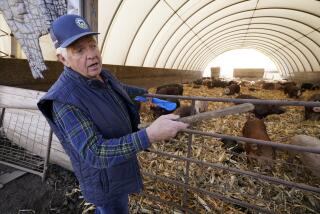Critics Have a Beef With USDA’s ‘Grass-Fed’ Plan
- Share via
WASHINGTON — Meat-eaters usually assume a grass-fed steak came from cattle contentedly grazing for most of their lives on lush pastures, not crowded into feedlots.
If the government has its way, the “grass-fed” label could be used to sell beef that didn’t roam the range and ate more than just grass.
The U.S. Department of Agriculture has proposed a standard for grass-fed meat that doesn’t say animals need pastures and that broadly defines grass to include things such as leftovers from harvested crops.
Critics say the proposal is so loose that it would let more conventional ranchers slap a grass-fed label on their beef, too.
“In the eye of the consumer, grass-fed is tied to open pasture-raised animals, not confinement or feedlot animals,” said Patricia Whisnant, a Missouri rancher who heads the American Grassfed Assn. “In the consumer’s eye, you’re going to lose the integrity of what the term ‘grass-fed’ means.”
All beef cattle graze on grass at the beginning of their lives. The difference generally is that cattle later characterized as grass-fed beef graze in pastures, while conventional cattle spend the last three or four months of their lives being fattened with corn or other grains in feedlots.
People buy grass-fed beef for many reasons: They want to avoid antibiotics commonly used in feedlots, they think it’s healthier, or they like the idea of supporting local farms and ranches.
Grass-fed beef is a leaner meat; fat tends to form around the muscle. With conventional corn-fed beef, the fat streaks the muscle in marble-like patterns.
“When you eat steak that is corn-finished, there’s a mouth-feel that you get specifically from the fat; it hangs there in the palate for quite a while,” said Thom Fox, the chef at Acme Chophouse in San Francisco and a member of the Chefs Collaborative.
“Grass-fed beef tends to have a much quicker finish,” he said. “The taste lasts for a few minutes and cleans itself off very fast.”
Demand for grass-fed products is intense, and producers are responding. By Whisnant’s estimate, the number of this type of farm has grown from about 40 seven years ago to around 1,000.
With so many producers rushing into the market, the definition of grass-fed varies. Some meat is sold as grass-fed when grass is only part of the animal’s diet.
Confusion has resulted. A survey by the National Cattlemen’s Beef Assn. found that half of consumers had heard of grass-fed beef, but only 28% believed it came from cows that grazed on grass their whole lives. Sixty percent thought the cows also ate other things, such as oats, corn, hay and alfalfa.
“The awareness is there, but yet I think there is confusion,” said Leah Wilkinson, food policy director for the association. “We want them to come out with something that won’t be misleading to consumers.”
Producers who keep cattle on pastures began asking the USDA in the late 1990s to set standards to help sell their beef as truly grass-fed. They want to send clear marketing signals to consumers inundated by labels such as “organic,” “natural,” “certified humane” or “hormone-free.”
The department has tried to come up with rules ever since, but it’s a bureaucratic process that can take years. Officials have proposed standards twice now, in 2002 and this year, that were greeted with protests from the industry.
Before a deadline for written comments last month, the department was inundated with more than 17,000 responses to its proposal.
The USDA is reluctant to regulate a cow’s time spent grazing because some parts of the country might suffer weather extremes that hurt pastures, said William Sessions, associate deputy administrator of the department’s livestock and seed program.
So officials provided leeway by proposing that only 99% -- rather than 100% -- of a cow’s diet come from grass forage, and by defining forage more broadly to include things such as corn stalks left over from harvests and silage, which is fermented grasses and legumes.
“With the geographic diversity found in the U.S., a farmer or rancher in Minnesota is going to have a little bit different grass-fed scheme than, say, one that’s located in Alabama, in the South where year-round grazing is available,” Sessions said.
“What we tried to do with this grass-fed claim is make it where anyone in the U.S. that wanted to make this claim could,” he said.
Insisting on access to pastures could be covered by another standard, such as the department’s rules for organic meat, Sessions said.
But that’s what many grass-fed producers are hoping to avoid.
The USDA’s organic standard requires that animals have unspecified access to the outdoors, and big organic dairy operations have been accused of exploiting the broad language to keep cows confined in barns.
“I’ve been an organic user for years, and I am disenchanted,” Whisnant said. “My personal opinion ... is that it’s lost meaning.”
“To me, the line in the sand is the confinement issue,” she said. “A grass-fed animal needs to be raised on pasture, and that’s not just token access to pasture from his feedlot, but he should get the majority of his ration from that growing pasture.”
More to Read
Sign up for Essential California
The most important California stories and recommendations in your inbox every morning.
You may occasionally receive promotional content from the Los Angeles Times.













